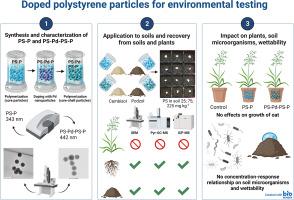NanoImpact ( IF 4.9 ) Pub Date : 2023-09-19 , DOI: 10.1016/j.impact.2023.100484 Martin Hoppe 1 , Jan Köser 1 , Georg Scheeder 1 , Axel Lamparter 1 , Kristof Dorau 1 , Lena Grüger 1 , Georg Dierkes 2 , Karsten Schlich 3

|
There is a lack of knowledge about the fate and impact of microplastics (MPs) and nanoplastics (NPs), as well as their potential uptake and impact on plants and microorganisms. The predicted environmental concentrations (PEC) of frequent polymers in soils are low, and therefore, difficult to detect with the available techniques, which explains the knowledge gaps. Therefore, model particles (polystyrene particles (PS-P), 343 nm) and palladium (Pd) nanoparticle-doped polystyrene particles (PS-Pd-PS-P, 442 nm) were synthesized, characterized, and subsequently applied to agricultural soils (Cambisol, Podzol, PS target contents: 25 mg kg−1, 75 mg kg−1, 225 mg kg−1). A combination of different techniques, such as inductively coupled plasma-mass spectrometry (ICP-MS), pyrolysis-gas chromatography–mass spectrometry (Pyr-GC–MS), dynamic light scattering (DLS), and scanning electron microscopy (SEM), were used to characterize the particles in the dispersions, soils and plants. The spiked soils were applied to a chronical plant toxicity test with oat (Avena sativa). The applied particle contents could be recovered from both soils by ICP-MS (Pd, 89% - 99%), and Pyr-GC–MS (PS, 73% - 120%). Moreover, non-aggregated particles in soils and on oat roots were visualized through SEM. The ratio obtained for the Pd contents in oat roots to that in the Cambisol (2.2–2.7) and the Podzol (2.3–2.6) implied that particles accumulated on the root surface or in the roots. No Pd was detected in the oat shoots, which indicated that no translocation occurred from the roots to the shoots. Despite particle accumulation at or in the roots, no clear effects on plant growth were observed. Furthermore, the soil microorganisms (Podzol) and the soil water repellency (Cambisol, Podzol) showed no clear monotone concentration-response relationship after exposure to PS-P and PS-Pd-PS-P. The findings are complex and illustrate the urgent need for further sophisticated experimental studies to elucidate the impacts of NPs on physicochemical soil function, plants, and soil organisms. The model PS-P doped with Pd nanoparticles significantly enhanced the development and validation of methods for investigating MPs and NPs in environmental matrices, highlighting their considerable potential for further studies.
中文翻译:

高等植物慢性毒性试验中的钯掺杂和未掺杂聚苯乙烯纳米塑料:对土壤、植物和铵氧化细菌的影响
人们对微塑料(MP)和纳米塑料(NP)的命运和影响以及它们对植物和微生物的潜在吸收和影响缺乏了解。土壤中常见聚合物的预测环境浓度 (PEC) 较低,因此很难用现有技术检测,这解释了知识差距。因此,合成、表征了模型颗粒(聚苯乙烯颗粒(PS-P),343 nm)和钯(Pd)纳米颗粒掺杂的聚苯乙烯颗粒(PS-Pd-PS-P,442 nm),并随后应用于农业土壤(甘必索尔、灰化土、PS目标含量:25 mg kg -1、75 mg kg -1、225 mg kg -1 )。不同技术的组合,如电感耦合等离子体质谱 (ICP-MS)、热解气相色谱-质谱 (Pyr-GC-MS)、动态光散射 (DLS) 和扫描电子显微镜 (SEM),用于表征分散体、土壤和植物中的颗粒。将加标土壤用于燕麦(Avena sativa)的长期植物毒性测试。ICP-MS(Pd,89% - 99%)和 Pyr-GC-MS(PS,73% - 120%)可以从两种土壤中回收施用的颗粒含量。此外,土壤中和燕麦根上的非聚集颗粒可通过 SEM 可视化。燕麦根中 Pd 含量与 Cambisol (2.2-2.7) 和 Podzol (2.3-2.6) 中 Pd 含量的比率表明颗粒积累在根表面或根中。燕麦芽中未检测到 Pd,这表明没有发生从根到芽的易位。尽管颗粒在根部或根部积累,但没有观察到对植物生长的明显影响。此外,暴露于PS-P和PS-Pd-PS-P后,土壤微生物(Podzol)和土壤拒水性(Cambisol、Podzol)没有表现出明显的单调浓度-响应关系。研究结果很复杂,表明迫切需要进一步复杂的实验研究来阐明纳米颗粒对土壤理化功能、植物和土壤生物的影响。掺杂 Pd 纳米颗粒的 PS-P 模型显着增强了研究环境基质中 MP 和 NP 的方法的开发和验证,凸显了它们进一步研究的巨大潜力。



























 京公网安备 11010802027423号
京公网安备 11010802027423号